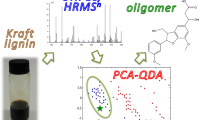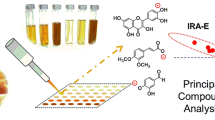Abstract
To enhance the characterization of wood extractives at molecular level, a detailed ultrahigh-resolution mass spectrometry (UHRMS)–based analytical methodology was developed in this work. The analytical strategies, including selection of compatible solvent for extraction, evaluation of ionization solvent for effective electrospray ionization, and multi-dimensional data analysis, were established to ensure a comprehensive characterization of complex compositions in wood extractives. Extraction capability of seven solvents with varied polarities was examined by a standard reference material of hardwood biomass and evaluated based on thousands of compounds which were much more than those discovered before. With a variety of data-processing approaches, including compound type distribution, double bond equivalent versus carbon number plot, and van Krevelen diagram, the chemodiversity of the extractives was fully explored from different perspectives. This work greatly expanded the compound library of wood extractives and could also provide guidance for the integrated composition analysis of other biomass materials.
Graphical abstract






Similar content being viewed by others
References
Higuchi T. Biosynthesis of Wood Components. In: Higuchi T, editor. Biochemistry and molecular biology of wood. Berlin: Springer Berlin Heidelberg; 1997. p. 93–262.
Pettersen RC. The chemical composition of wood. In: The chemistry of solid wood. American Chemical Society; 1984. p. 57–126.
Schultz TP, Nicholas DD. Naturally durable heartwood: evidence for a proposed dual defensive function of the extractives. Phytochem. 2000;54:47–52. https://doi.org/10.1016/S0031-9422(99)00622-6.
Grabner M, Müller U, Gierlinger N, Wimmer R. Effects of heartwood extractives on mechanical properties of Larch. IAWA J. 2005;26:211–20. https://doi.org/10.1163/22941932-90000113.
Pandey KK. A note on the influence of extractives on the photo-discoloration and photo-degradation of wood. Polym Degrad Stab. 2005;87:375–9. https://doi.org/10.1016/j.polymdegradstab.2004.09.007.
Xu C, Qin M, Fu Y, Liu N, Hemming J, Holmbom B, Willför S. Lipophilic Extractives in Populus × euramericana “Guariento” Stemwood and Bark. J Wood Chem Technol. 2010;30:105–17. https://doi.org/10.1080/02773810903085994.
Serreqi AN, Leone R, Del Rio LF, Mei S, Fernandez M, Breuil C. Identification and quantification of important steryl esters in aspen wood. J Am Oil Chem Soc. 2000;77:423. https://doi.org/10.1007/s11746-000-0066-9.
Pietarinen SP, Willför SM, Ahotupa MO, Hemming JE, Holmbom BR. Knotwood and bark extracts: strong antioxidants from waste materials. J Wood Sci. 2006;52:436–44. https://doi.org/10.1007/s10086-005-0780-1.
Celedon JM, Chiang A, Yuen MMS, Diaz-Chavez ML, Madilao LL, Finnegan PM, Barbour EL, Bohlmann J. Heartwood-specific transcriptome and metabolite signatures of tropical sandalwood (Santalum album) reveal the final step of (Z)-santalol fragrance biosynthesis. Plant J. 2016;86:289–99. https://doi.org/10.1111/tpj.13162.
Ma D, Reichelt M, Yoshida K, Gershenzon J, Constabel CP. Two R2R3-MYB proteins are broad repressors of flavonoid and phenylpropanoid metabolism in poplar. Plant J. 2018;96:949–65. https://doi.org/10.1111/tpj.14081.
Horvath AL. Solubility of structurally complicated materials: I. wood. J Phys Chem Ref Data. 2006;35:77–92. https://doi.org/10.1063/1.2035708.
Hsu CS, Drinkwater D. Gas chromatography-mass spectrometry in the petroleum industry. In: Current practice of gas chromatography-mass spectrometry. New York: Marcel Dekker, Inc; 2001. p. 55–94.
Gutiérrez A, del Río JC, González-Vila FJ, Martín F. Analysis of lipophilic extractives from wood and pitch deposits by solid-phase extraction and gas chromatography. J Chromatogr A. 1998;823:449–55. https://doi.org/10.1016/S0021-9673(98)00356-2.
Liu R, Wang C, Huang A, Lv B. Identification of odorous constituents of southern yellow pine and China fir wood: the effects of extractive removal. Anal Methods. 2018;10:2115–22. https://doi.org/10.1039/C7AY02885G.
Qiu H, Liu R, Long L. Analysis of chemical composition of extractives by acetone and the chromatic aberration of Teak (Tectona Grandis L.F.) from China. Molecules. 2019;24 https://doi.org/10.3390/molecules24101989.
Fernandez MP, Watson PA, Breuil C. Gas chromatography–mass spectrometry method for the simultaneous determination of wood extractive compounds in quaking aspen. J Chromatogr A. 2001;922:225–33. https://doi.org/10.1016/S0021-9673(01)00948-7.
Miranda I, Sousa V, Ferreira J, Pereira H. Chemical characterization and extractives composition of heartwood and sapwood from Quercus faginea. PLoS One. 2017;12:e0179268. https://doi.org/10.1371/journal.pone.0179268.
Esteves B, Graça J, Pereira H. Extractive composition and summative chemical analysis of thermally treated eucalypt wood. Holzforschung. 2008;62:344–51. https://doi.org/10.1515/HF.2008.057.
Bataineh M, Scott AC, Fedorak PM, Martin JW. Capillary HPLC/QTOF-MS for characterizing complex naphthenic acid mixtures and their microbial transformation. Anal Chem. 2006;78:8354–61. https://doi.org/10.1021/ac061562p.
Tholl D, Boland W, Hansel A, Loreto F, Röse USR, Schnitzler J-P. Practical approaches to plant volatile analysis. Plant J. 2006;45:540–60. https://doi.org/10.1111/j.1365-313X.2005.02612.x.
Hsu CS, Hendrickson CL, Rodgers RP, McKenna AM, Marshall AG. Petroleomics: advanced molecular probe for petroleum heavy ends. J Mass Spectrom. 2011;46:337–43. https://doi.org/10.1002/jms.1893.
Pandey AMM. Proteomics to study genes and genomes. Nature. 2000;405:837–46. https://doi.org/10.1038/35015709.
Marshall AG, Rodgers RP. Petroleomics: the next grand challenge for chemical analysis. Acc Chem Res. 2004;37:53–9. https://doi.org/10.1002/chin.200415280.
Hsu CS, Liang Z, Campana JE. Hydrocarbon characterization by ultrahigh resolution Fourier transform ion cyclotron resonance mass spectrometry. Anal Chem. 1994;66:850–5. https://doi.org/10.1021/ac00078a015.
Rowland SM, Smith DF, Blakney GT, Corilo YE, Hendrickson CL, Rodgers RP. Online coupling of liquid chromatography with Fourier transform ion cyclotron resonance mass spectrometry at 21 T provides fast and unique insight into crude oil composition. Anal Chem. 2021;93:13749–54. https://doi.org/10.1021/acs.analchem.1c01169.
Ohno T, He Z, Sleighter RL, Honeycutt CW, Hatcher PG. Ultrahigh resolution mass spectrometry and indicator species analysis to identify marker components of soil- and plant biomass-derived organic matter fractions. Environ Sci Technol. 2010;44:8594–600. https://doi.org/10.1021/es101089t.
Vanholme R, Morreel K, Darrah C, Oyarce P, Grabber JH, Ralph J, Boerjan W. Metabolic engineering of novel lignin in biomass crops. New Phytol. 2012;196:978–1000. https://doi.org/10.1111/j.1469-8137.2012.04337.x.
Qi Y, Hempelmann R, Volmer DA. Two-dimensional mass defect matrix plots for mapping genealogical links in mixtures of lignin depolymerisation products. Anal Bioanal Chem. 2016;408:4835–43. https://doi.org/10.1007/s00216-016-9598-5.
Qi Y, Volmer DA. Chemical diversity of lignin degradation products revealed by matrix-optimized MALDI mass spectrometry. Anal Bioanal Chem. 2019;411:6031–7. https://doi.org/10.1007/s00216-016-9598-5.
Shi Q, Pan N, Long H, Cui D, Guo X, Long Y, Chung KH, Zhao S, Xu C, Hsu CS. Characterization of middle-temperature gasification coal tar. Part 3: Molecular composition of acidic compounds. Energy Fuel. 2013;27:108–17. https://doi.org/10.1007/s00216-016-9598-5.
Cech NB, Enke CG. Practical implications of some recent studies in electrospray ionization fundamentals. Mass Spectrom Rev. 2001;20:362–87. https://doi.org/10.1002/mas.10008.
Kebarle P, Verkerk UH. Electrospray: from ions in solution to ions in the gas phase, what we know now. Mass Spectrom Rev. 2009;28:898–917. https://doi.org/10.1021/la00086a016.
Kim S, Kramer RW, Hatcher PG. Graphical method for analysis of ultrahigh-resolution broadband mass spectra of natural organic matter, the Van Krevelen diagram. Anal Chem. 2003;75:5336–44. https://doi.org/10.1021/ac034415p.
Hockaday WC, Purcell JM, Marshall AG, Baldock JA, Hatcher PG. Electrospray and photoionization mass spectrometry for the characterization of organic matter in natural waters: a qualitative assessment. Limnol Oceanogr Methods. 2009;7:81–95. https://doi.org/10.4319/lom.2009.7.81.
Koch BP, Dittmar T. From mass to structure: an aromaticity index for high-resolution mass data of natural organic matter. Rapid Commun Mass Spectrom. 2006;20:926–32. https://doi.org/10.1002/rcm.2386.
Smith JS, Laskin A, Laskin J. Molecular characterization of biomass burning aerosols using high-resolution mass spectrometry. Anal Chem. 2009;81:1512–21. https://doi.org/10.1021/ac8020664.
Afendi FM, Okada T, Yamazaki M, Hirai-Morita A, Nakamura Y, Nakamura K, Ikeda S, Takahashi H, Altaf-Ul-Amin M, Darusman LK, Saito K, Kanaya S. KNApSAcK Family Databases: integrated metabolite–plant species databases for multifaceted plant research. Plant Cell Physiol. 2012;53:e1. https://doi.org/10.1093/pcp/pcr165.
Nakamura Y, Afendi FM, Parvin AK, Ono N, Tanaka K, Hirai Morita A, Sato T, Sugiura T, Altaf-Ul-Amin M, Kanaya S. KNApSAcK Metabolite Activity Database for retrieving the relationships between metabolites and biological activities. Plant Cell Physiol. 2014;55:e7. https://doi.org/10.1093/pcp/pct176.
Funding
This work was financially supported by the National Natural Science Foundation of China (No. 21874153) and Science Foundation of China University of Petroleum, Beijing (No. 2462017BJB09).
Author information
Authors and Affiliations
Corresponding author
Ethics declarations
Conflict of interest
The authors declare no competing interests.
Additional information
Publisher’s note
Springer Nature remains neutral with regard to jurisdictional claims in published maps and institutional affiliations.
Supplementary Information
Below is the link to the electronic supplementary material.
Rights and permissions
About this article
Cite this article
Hu, W., Pan, Q., Wang, Y. et al. Expansion of the composition library for chemodiversity of hardwood extractives at molecular level by ultrahigh-resolution mass spectrometry. Anal Bioanal Chem 414, 2687–2698 (2022). https://doi.org/10.1007/s00216-022-03909-8
Received:
Revised:
Accepted:
Published:
Issue Date:
DOI: https://doi.org/10.1007/s00216-022-03909-8




